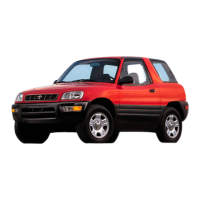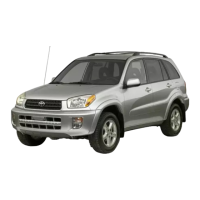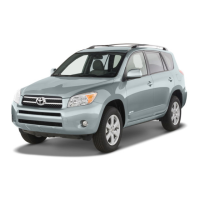Do you have a question about the Toyota RAV4 EE and is the answer not in the manual?
Introduction to the vehicle's instruments and controls, including panel and cluster details.
Information on vehicle keys, doors, and related systems for operation and security.
Details on master and sub keys, their functions, and transponder chip information.
Information on electronic and mechanical keys for vehicles with smart entry and start systems.
Explanation of the engine immobilizer system as a theft prevention measure.
Operating instructions for the wireless remote control key fob and electronic key.
Procedures for locking and unlocking vehicle doors using the key or remote control.
Procedures for locking and unlocking side doors using the key or smart entry system.
Procedure for locking and unlocking doors without using the key.
Overview of the vehicle's occupant restraint systems, including seats, airbags, and seat belts.
Information specific to seats and their adjustment, including front and rear seating precautions.
General safety advice and precautions for using seat belts correctly.
Explanation of the seat belt pretensioner system and its activation.
Information on the function and deployment of SRS front airbags for driver and passenger.
Details on the SRS system including driver, knee, and front passenger airbags.
Information on the SRS side airbags and curtain shield airbags for enhanced side impact protection.
How to manually turn the front passenger airbag and side airbag on or off.
Guidelines for selecting and installing child restraint systems based on child size and vehicle compatibility.
Information on adjusting the steering wheel and various mirrors for optimal visibility and comfort.
Comprehensive guide to operating vehicle lights, wipers, and defogger systems.
Operation of headlights and turn signals without automatic light control.
Operation of headlights and turn signals with automatic light control features.
Operation of front and rear fog light systems for improved visibility.
Detailed operation of windshield wipers and washers, including intermittent and automatic modes.
How to operate the rear window wiper and washer system.
Operation of the defogger system for the rear window and outside mirrors.
Guide to understanding vehicle gauges, meters, and warning indicators.
Information on reading the fuel gauge and the low fuel warning light.
How to read the engine coolant temperature gauge and what to do if overheating occurs.
Overview of the multi-information display and its various information outputs.
Guide to understanding and responding to various service reminders and audible alerts.
Comprehensive guide to operating the engine switch, transmission, and parking brake.
Operation of the ignition switch for vehicles without smart entry and start systems.
Operation of the push-button start system for vehicles with smart entry and start systems.
Detailed operation of the 4-speed automatic transmission, including shift lever positions.
Operation of the 6-speed automatic transmission, including shift lever and paddle shift controls.
How to use the paddle shift switches for manual gear selection and engine braking.
How to use engine braking effectively in different transmission modes.
Explanation of the Multidrive transmission system, including its shift lock and mode operations.
Operation of the 5-speed and 6-speed manual transmissions, including shift patterns.
How the traction control system operates to prevent wheel spin on slippery surfaces.
Explanation of how the Active Torque Control 4WD system distributes engine torque.
How the VSC+ system assists in preventing skidding and maintaining vehicle control.
How the downhill assist control system aids deceleration on steep hills.
How the hill-start assist control system helps prevent rolling backward on slopes.
How to apply and release the parking brake safely.
How to operate the cruise control system for maintaining a set speed.
Guide to operating the vehicle's audio system and hands-free phone features.
Detailed description of audio system controls and features, including buttons and their functions.
Various methods for making phone calls using the hands-free system.
How to receive calls and adjust settings when the vehicle is stopped or in motion.
Overview of the air conditioning system, including manual and automatic controls.
Identification and function of manual air conditioning controls.
Control settings for defogging the windshield.
Identification and function of automatic air conditioning controls.
Proper fuel selection and octane requirements for satisfactory engine performance.
Proper fuel selection and requirements for diesel engines, including sulfur content and cetane number.
Overview of the tandem master cylinder brake system and brake booster function.
Procedure for starting the engine using the cranking hold function with smart entry.
Starting procedure for gasoline and diesel engines with the smart entry and start system.
Tips for safely using the smart entry and start system while driving and parking.
Guidance on actions to take in various emergency situations.
Basic troubleshooting steps for a gasoline engine that will not start.
Basic troubleshooting steps for a diesel engine that will not start.
Safety procedures and instructions for jump starting a vehicle's battery.
Actions to take if the engine stalls while the vehicle is in motion.
Procedure to follow if the engine coolant temperature gauge indicates overheating.
Information about the emergency tire repair kit for temporary flat tire repair.
Steps for handling a flat tire on standard tires.
Steps for removing the flat tire and installing the spare tire.
Procedures for reinstalling and tightening wheel nuts correctly.
Important considerations and safety advice for towing the vehicle.
Procedure for stopping the vehicle in an emergency when normal braking is impossible.
General safety precautions and warnings for performing DIY maintenance tasks.
Maintenance procedures related to the engine and chassis components.
How to check and maintain the engine oil level for optimal performance.
How to check and maintain the engine coolant level, including type selection.
Importance of proper tire inflation and how to check it.
How to check tire treadwear and when to replace tires.
Maintenance procedures related to the vehicle's electrical system.
How to check for blown fuses and replace them correctly.
Procedures for replacing headlight bulbs.
| Brand | Toyota |
|---|---|
| Model | RAV4 EE |
| Category | Automobile |
| Language | English |












